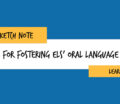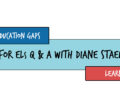
Imagine the following scenario. Ameena is an English learner (EL) in the 8th grade who entered a U.S. public school for the first time one and a half years ago. Her overall proficiency level is 3 on a scale in her state where 1=entering and 6=proficient. When her teachers use complex grade level text for whole group instruction, Ameena struggles to comprehend and appears not to be learning the content. A team of teachers and specialists meets to discuss reading supports for her. One teacher suggests they focus on supporting the challenging vocabulary in English. Another colleague feels the texts should be re-written at Ameena’s reading level. Each teacher at the meeting offers a different suggestion. With so many different suggestions, what should they do?
In this blog post I will share with you six steps to consider when supporting ELs in accessing complex, grade level text. These steps are illustrated in our handy sketch note below. Feel free to print it, post it, and share it!

1. Select a short passage (to start).
The first step is to select a short passage for one lesson. Often, lengthy textbook passages do not offer any additional benefits to ELs. Depending on your students’ ages, reading levels, and English proficiency, select a passage of text you will be able to focus on in one session and will afford meaningful learning.
After you select a short passage, analyze the academic language demands at the word, sentence, discourse, and sociocultural levels. In other words, ask yourself what academic vocabulary, grammatical structures, discourse styles, and additional background and/or cultural knowledge will be needed in order for ELs to access and comprehend the meaning of the text? Identifying these three key levels (word, sentence, discourse) all within the sociocultural context (WIDA, n.d) is the first step in preparing your ELs to access the content.
If you are using a textbook that already highlights key information for ELs, including vocabulary, why isn’t it a good idea to just rely on this? Built-in support from the publisher can be a very helpful resource, but we know that it alone is not sufficient. It is not tailored for your specific students; it doesn’t account for their background knowledge and abilities, and therefore cannot build on what they know and provide necessary support in the appropriate areas, which brings us to the next step:
|
2. Build on your ELs’ experience and background knowledge.
We believe in beginning with an assets-based approach to instructing our English learners. First consider the question, what background knowledge—or prior knowledge—do they have that will provide support in understanding the text? We need to both activate and build schema for ELs as this has a direct and positive influence on new learning and comprehension of what they read (Goldenberg, 2011).
There are many different activities you can use to both activate and build background knowledge, such as visuals, image discussion, brief video clips, short teacher-developed texts with guiding and supplementary questions, home language supports in the text, and/or web links (Staehr Fenner & Snyder, 2017). It is important to remember to keep all background knowledge instruction concise by predetermining what background knowledge is essential to understanding the text.
|
3. Pre-teach or gloss vocabulary.
Just as ELs need background knowledge to comprehend complex texts, they also need access to key vocabulary. As you plan the lesson, it is important to determine the specific vocabulary they will need to understand the main points of the text.
Keep in mind that the words you select may not match the words the publisher has selected to highlight. You have the advantage of knowing your students and being able to pre-assess their understanding of key vocabulary. Make sure to distinguish between words that are not key for understanding (words that are explained or glossed within the text itself, for example) and words that your learners will need your support with (Baker et al., 2014).
There are many different approaches to pre-teaching vocabulary: you can use visuals, realia, gestures, student-created definitions, examples and non-examples, synonyms and antonyms, to name a few.
It is important first to narrow your focus to the most essential words and the most effective way to get the definition across. Second, always keep the pre-teaching in context. Finally, avoid pre-teaching words whose meaning can quickly be accessed by utilizing clues in the surrounding text. For more on this topic, keep reading!
You can also gloss selected words unfamiliar to ELs by highlighting them in a glossary in the margin. Consider adding home language support (for classes with students who share a few home languages and are literate in their home language) and/or images to the glossary for additional support.
|
4. Amplify language as needed.
In the past, many educators tended to simplify texts so that ELs could read them with little assistance. This involved the laborious rewriting of texts and resulted in the unintentional removal of complex but rich language, contextual clues, and even many cognates. Today’s research advocates for the combination of using complex text with English learners and supporting their access to the text with strategies such as amplification of language (Gibbons, 2002; Walqui, 2006; Van Lier & Walqui, 2010; Billings & Walqui, 2014).
Using the passage you selected in Step 1, you can amplify the language by building definitions and explanations of difficult language into the text. In the example below from the book Inside Out and Back Again, the added amplification is in parentheses. In this example, we also added a picture glossary to provide further support for independent language access.

Along with providing amplified text, you may wish to consider planning a brief mini-lesson on using contextual clues to figure out word meanings. You can have students develop additional skills lessons on using independent word-learning strategies to help them benefit fully from amplified text.
|
5. Scaffold readability.
Next, you may wish to highlight existing text features or build in your own text features to provide additional structure to support your ELs’ independent comprehension of the text by using text features. You may choose to add images, bolded or italicized text, headings and subheadings, as well as highlighting key information in order to scaffold readability for ELs.
One thing to note is that your ELs will benefit from explicit mini-lessons in how to use text features such as images, bolded text and subheadings to both locate and understand information (Haynes, 2016).
|
6. Support comprehension.
Finally, it is helpful to develop a series of text dependent questions (TDQs) to draw ELs’ attention to key language and concepts as they read the text for multiple purposes (Fisher & Frey, 2015). Additionally, TDQs can support ELs in drawing connections between different texts. Your text may have comprehension questions already created for it. If this is the case, you will need to approach them critically and select only the essential questions that will help your ELs understand the key concepts (e.g., character, theme, point of view, bias), key vocabulary, and sentence structure as aligns with the lesson standards and objectives.
Finally, it is helpful to develop a series of text dependent questions (TDQs) to draw ELs’ attention to key language and concepts as they read the text for multiple purposes (Fisher & Frey, 2015). Additionally, TDQs can support ELs in drawing connections between different texts. Your text may have comprehension questions already created for it. If this is the case, you will need to approach them critically and select only the essential questions that will help your ELs understand the key concepts (e.g., character, theme, point of view, bias), key vocabulary, and sentence structure as aligns with the lesson standards and objectives.
In addition to writing or selecting key TDQs, it is helpful to scaffold them for your ELs (Staehr Fenner & Snyder, 2017). Consider providing glossary support, a word bank, and either sentence stems or frames to reduce the language load. An additional scaffold would be to develop supplementary questions to aid students in answering a more complex TDQ. Take a look at our blog posts on Colorín Colorado for examples of how to scaffold TDQs for ELs with 2nd grade and 6-8 grade sample texts examples.
|
Final Thoughts
We have provided these six steps as a starting place for making complex texts accessible for ELs. It may not be necessary to always follow all six steps with every text, but it can be helpful to consider which steps you will implement to support your ELs in accessing the texts you choose. Post our sketch note next to where you work as a handy planning tool and let us know what you find helpful!
Tweet an image of your text or activity in which you’ve made complex text accessible to your ELs and tag us @SupportEduc and we’ll share it with our Twitter community of EL educators. Please reach out if you have any questions at info@supported.com.



